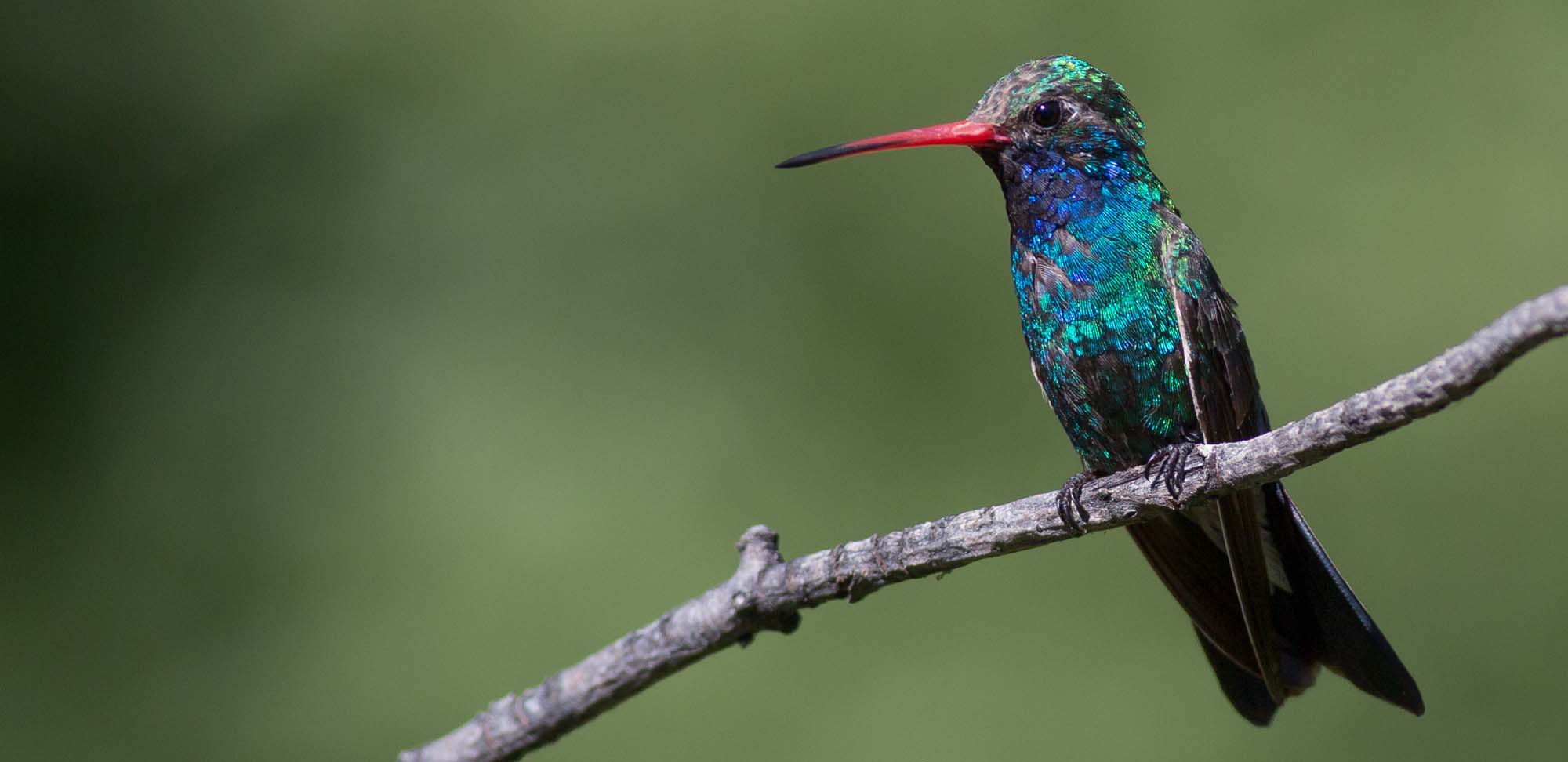Not sure which Arizona tour to choose? Click to see a complete listing and comparison of all our Arizona trips.
Arizona's Southeast is a land of contrasts where forested, block-fault mountains rise above the Sonoran Desert plains. Wild canyons ring the mountain ranges carrying cool streams to the dry expanses below. This remarkable geographic diversity is reflected in the region's tremendous variety of plants and animals, especially birds. Indeed, Southeast Arizona has a greater variety of breeding birds than does any other area of comparable size in the US. And many of the birds of Southeast Arizona occur only here within the US, their ranges barely extending north from Mexicoo.
Our ten-day tour is designed to give us an excellent chance of seeing virtually all of Southeast Arizona's breeding birds. Among the specialties we seek are Zone-tailed and Gray hawks, ten or more species of hummingbirds including Violet-crowned and White-eared, Arizona Woodpecker, Rose-throated Becard (rare), Thick-billed and Tropical kingbirds, Sulphur-bellied, Dusky-capped, and Buff-breasted flycatchers, Greater Pewee, Northern Beardless-Tyrannulet, Mexican Chickadee, Bendire's Thrasher, Red-faced Warbler, Painted Redstart, Abert's Towhee, Rufous-winged, Five-striped, and Botteri's sparrows, Yellow-eyed Junco, and the beautiful Elegant Trogon.
Late July through August is an ideal time to visit Southeast Arizona. In a typical year, the late-summer prevailing winds bring moisture from the west coast of Mexico. Clouds begin to build in mid-morning and cooling, isolated afternoon rains refresh the desert and mountains. It is not uncommon to watch a rain shower pass a few hundred yards away without feeling a drop of rain. These rains can turn the desert and grasslands into a backdrop for carpets of wildflowers. The summer rain is also the onset of breeding for some of the local bird specialties. Montezuma Quail and Botteri's and Cassin's sparrows are at the peak of their singing and easier to locate. This time of year has also proved to be better than the spring for the appearance of Mexican vagrants as these post-breeding wanderers move north.
Although many of the nightbirds have completed their nesting by early August and are less likely to be vocalizing (hence, less likely to be seen), we will still make an effort to locate as many as possible. Southeast Arizona boasts no fewer than eleven species of breeding owls, including Whiskered and Western screech-owls, Flammulated Owl (very difficult in August), Northern (Mountain) Pygmy-Owl, Elf Owl (the world's smallest owl), Burrowing Owl, and the magnificent Spotted Owl. The Mexican Whip-poor-will is also a possibility. Nocturnal outings can also be productive for seeing mammals. A few of the species we could encounter (day or night) are Collared Peccary, White-tailed Deer, Black Bear, Western Spotted, Hooded, Striped, and Western Hognose skunks, Ringtail, White-nosed Coati, Bobcat, and even Mountain Lion.
Our route forms a loop beginning and ending in Tucson with stops in Willcox, the Chiricahua, Huachuca, and Santa Rita mountains, the Patagonia/Sonoita Creek area, Nogales, the Pajarito and Atascosa mountains, and California Gulch. Scenery is spectacular, one-night stands are few, and the itinerary is arranged so as to maximize our chances for the local specialties as well as any vagrants that might appear.
For a similar itinerary in May, see our ARIZONA: BIRDING THE BORDER tour.
Select the KEY INFO tab or click here for our itinerary plus space requests, status, fees, limits, and guides for any departure.
Client comment
"I had taken this same tour last year and really enjoyed it so I decided to do it again. It was an excellent birding experience. Chris Benesh is a fantastic trip leader -- he really makes the trip worthwhile. The Field Guides office staff service was excellent." B.T., ARIZONA'S SECOND SPRING tour participant
"This was our fifth birding tour with Field Guides and all have been great, so we look forward to more trips with the company. It was a wonderful experience! We had a list of birds we hoped to find and saw them all, plus a few other lifers we hadn't expected. Plus, the Chiricahua, Huachuca, and Santa Rita mountains are spectacularly beautiful, especially during the monsoon rains when clouds build to dramatic heights in the late afternoon. We would definitely travel with guide Cory Gregory again. Cory loves birds deeply and is a very talented spotter (by ear and visual), like all Field Guides leaders we've traveled with. He also worked to make sure we saw the birds and could identify them again. The Field Guides office staff was very responsive and helpful." K.L., ARIZONA SECOND SPRING tour participant
"It was an awesome experience. It was fun. We had a fairly quiet group, but guide Chris Benesh livened it up. Chris is an outstanding guide. He identifies the birds so quickly both visually and hearing their calls. We would love to do other trips with him. Your office service was excellent. It was a very well-run tour from the moment I first inquired about it to our last day." J.W., ARIZONA'S SECOND SPRING tour participant
Other Tours in USA
ALASKA FALL GOLDMINE: Rarities on the Pribilofs & Ross's Gulls in BarrowALASKA: NO PLACE LIKE NOME
ALASKA: THE GREAT LAND
ARIZONA NIGHTBIRDS & MORE
ARIZONA WINTER SPECIALTIES
ARIZONA: BIRDING THE BORDER
BIRDING THE DAKOTAS: Prairies, Black Hills & Badlands
COLORADO GROUSE
FALL FOR CAPE MAY
FLORIDA: Mangroves & Migrants
HAWAII
LOUISIANA: YELLOW RAILS & CRAWFISH TAILS
MAINE IN FALL: Seabirds & Coastal Migrants
MICHIGAN: GREAT LAKES GRANDEUR
NEW MEXICO: Birding the Land of Enchantment
NORTHERN ARIZONA'S CANYONS & CONDOR
OREGON: From the Coast to the Cascades
SLICE OF CALIFORNIA: Seabirds to Sierra
SOUTH TEXAS RARITIES
SPRING IN CAPE MAY
TEXAS COAST MIGRATION SPECTACLE


